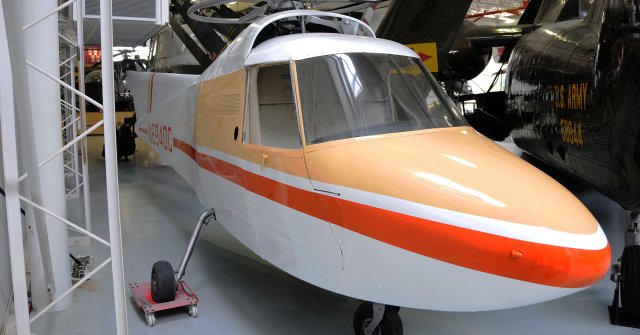
By Nathan Pfau, Army Flier Staff WriterFebruary 22, 2018
FORT RUCKER, Ala. — Before turbine engines took over the world of rotor-wing Aviation, a proof-of-concept system revolutionized helicopter flight with a radical new rotor design.
The Lockheed CL-475 is as rare an aircraft as they come and it sits in the U.S. Army Aviation Museum. As the only one in the world, the aircraft was a proof of concept that was never designed to go into production, according to Bob Mitchell, U.S. Army Aviation Museum curator.
The CL-475 was Lockheed’s first venture into the realm of rotor-wing Aviation and, as a result, the aircraft had the appearance of an airplane without wings. But despite its unusual design, the technology it provided worked surprisingly well, said Mitchell.
“Back in the late 1950s, Lockheed was looking at the current helicopter designs … and one thing the company noted was that the rotor technologies of the time afforded a very unstable platform,” said the curator. “They were hard to fly and had to be constantly adjusted and maintained to keep in level flight. So, they started looking at the rotor systems on them and realized that there were just too many moving parts.
“Back then, during the rotation of a rotor system, it does a number of things — it flaps, it feathers, hunts, it leads, it lags — all in an effect to maintain lift on the rotor system,” he continued. “With all of this going on, there is a lot of vibration and a lot of instability in that system, so Lockheed started looking at a hingeless rotor design, which would later be known as a rigid rotor system.”
What the company came up with was the CL-475 that worked with a gyro-synchronized rotor system that utilized a gyroscope to adjust the pitch and other movements of the rotor system to eliminate many of the moving parts. The first version of the aircraft featured a two-blade system, which was found to be unsuccessful, but when the engineers came up with a three-bladed system, they found the aircraft became very steady, said Mitchell.
With the addition of the extra blade, the vibration of the aircraft was reduced and less RPM was needed to achieve lift.
“Once they went with the three-bladed system, they put it on the aircraft and tweaked it here and there, and now this was a completely different aircraft — it was very stable,” said the curator.
Another benefit of the gyro-synchronized rotor system was that no matter the lateral load that was placed on the aircraft, within reason, the fuselage would always find center and hover in a stabilized latitude.
The Lockheed engineers further proved the reliability of the gyro-synchronized rotor system by adding a long arm off the side of the aircraft with a seat attached, and placed a person in the seat, said Mitchell.
“With most aircraft, you’re going to get a lean to the fuselage because it’s trying to compensate for that weight out there, whereas the CL remained level in flight even with that load,” he said. “The flexing system with the rotor system was able to compensate for that.”
Although the CL-475 never went into production, the Army was impressed with its rotor design and ultimately awarded a contract to pursue the technology, which subsequently led to the creation of the XH-51 and then the Cheyenne program.
“The CL-475 basically broke the paradigm of the helicopter rotor systems of the time, and we’re lucky to have it in our collection,” said the curator. “It was designed simply to test the concept, and once it proved that it worked, they kept all of the telemetry and data, and moved on to the next evolution.”
Mitchell said it’s a wonder that the aircraft survived at all, especially considering it was only a proof of concept. The helicopter came to the museum from the National Air and Space Museum of the Smithsonian Institution, and spent the last year under restoration before being moved into its rightful place at the home of Army Aviation.





